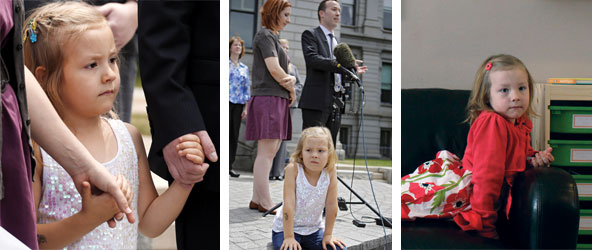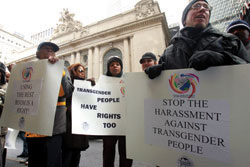For young people, transgender life means stress and confusion over restrooms, sports and harassment

The sibling of three sisters and one brother, Coy Mathis plays at home early this year. Photo by Brennan Linsley/AP/Corbis.
Coy Mathis, 7, was born male. But as a toddler Coy chose items traditionally associated with girls, like tutus and swimsuits featuring the cartoon character Dora the Explorer.
When Coy started to talk, the child said she saw herself as a girl. Kathryn and Jeremy Mathis enrolled their child in kindergarten as a male, but by November Coy became depressed when people referred to her as a boy. It interfered with the child’s learning, according to an administrative ruling.
“Not even my teacher knows I’m a girl,” Coy reportedly told her parents after an educator at a Fountain, Colo., school made the child join the boys’ line in music class. A therapist diagnosed Coy with gender dysphoria, the clinical term for those who are discontent with their birth sex.
Even children as young as Coy may know they are transgender, says Coy’s lawyer, Michael D. Silverman, executive director of the Transgender Legal Defense & Education Fund.
“It’s body image,” says Silverman of New York City. “They know, and often will ask the question: ‘Why does my body look like this—and not like that?’”
Coy’s parents decided that their child should be treated as a girl everywhere, including school. Initially, the school was “really fantastic” about supporting the Mathis family’s decision, Coy’s parents said in a February civil rights filing with the Colorado Civil Rights Division.
But that changed in first grade, when the Fountain-Fort Carson School District (near Colorado Springs) and its lawyer decided that Coy could no longer use the girls’ restroom, according to the family’s filing. Instead, the district decided Coy should use the boys’ restroom or single-user restrooms in the health office and the faculty area.
The district’s reasoning, the filing states, was the concern that as Coy got older other students might be uncomfortable sharing the girls’ restroom with a person who was born male. Also, the agency thought that banning Coy from the girls’ restroom would lessen chances of harassment or bullying.
The Civil Rights Division filing alleges that the school district discriminated against Coy based on the child’s female sex and transgender sexual orientation. And the filing notes that the government recognizes the child’s sex as female on her U.S. passport and state-issued ID. For both, letters from her doctor were required, with him stating that based on his care of Coy, his medical opinion is that her gender is female.

In June, the Colorado Civil Rights Division ruled that Coy Mathis’ school district discriminated against her by insisting that she use boys’ or single-user restrooms, the first such ruling in the country. Photos by AP Photo/Ed Andrieski(2), Brennan Linsley/AP.
SCHOOLS AND THE LAW
The Mathises’ filing is among an increasing number of complaints against school districts involving transgender students, says Asaf Orr, a staff attorney with the San Francisco-based National Center for Lesbian Rights. And there will likely be more in the future, he says. There are a variety of state, county and municipal laws regarding transgender individuals and civil rights, Orr says, which is why most of the cases involving schools are filed in state court or with human rights commissions.
There’s no specific federal law that addresses schools and transgender students, so some filings cite similar federal employment cases, among them Macy v. Holder, a key 2012 Equal Employment Opportunity Commission finding that unfair workplace treatment of transgender people was a form of sex discrimination illegal under Title VII of the Civil Rights Act of 1964.
“I anticipate that we will start seeing an increase of cases filed in state and federal court in the next year or so,” Orr says, adding that more schools are developing policies related to creating safe, supportive environments for all students, including transgender students.
About 500 to 1,000 school districts have policies regarding transgender students, he adds, and there are statewide school policies in Connecticut, Massachusetts and Washington.
And in California, Gov. Jerry Brown recently signed a bill that allows students there to join sports teams and use facilities, including restrooms, that correspond with their gender identity.
Single-sex restrooms are often the tipping point. Schools are tasked with creating safe, supportive school environments, as well as behavior policies that don’t violate constitutional rights, says Sonja Trainor, director of the National School Boards Association’s Council of School Attorneys in Alexandria, Va.
“It’s a balancing act; it’s not a clean line,” she says. “Schools are generally concerned about students’ safety, and they’re concerned about disruptions.”
Ally Windsor Howell, an attorney who is transgender, is the author of Transgender Persons and the Law, published this summer by the ABA.
Howell, 64, of Elmira, N.Y., transitioned from male to female in 2002. She says she identified as female in grade school.
“I hinted at it a few times when I was a kid, but the blowback then was such that I knew I should get deeper in the closet,” says the Alabama native.
Although the country has come a long way in transgender issues, Howell adds, we have a ways to go—including in education. Relegating transgender students to single-unit restrooms demonstrates that.
“It relates to the irrational fears folks have,” Howell says. “If someone is doing something untoward in the bathroom, that’s not a transgender issue. That’s a whole different kind of issue, which relates to conduct the law already regulates.”
In Coy’s case, the Colorado Civil Rights Division issued a probable cause determination in June that Coy was discriminated against in a public accommodation. Coy’s family has moved to the Denver area since filing the complaint, and as of August the respondents had not stated whether they will seek a full hearing regarding the determination.
William Kelly Dude, a Colorado Springs lawyer who represents the Fountain-Fort Carson School District, did not return phone calls seeking comment on the case. The school district issued a statement to the media shortly after the determination was released.
“The district feels it carefully considered the best interest of all children in the district, including Coy, when making its decision and believes that its option of permitting Coy the use of any of three single-user, gender-neutral bathrooms on the same floor as the first-grade classroom was a reasonable compromise which the family refused to consider,” the release stated.
According to the Civil Rights Division, the school district argued that Colorado law allows the segregation of restroom facilities if the restriction has a “bonafide relationship to the goods, services, facilities, privileges, advantages or accommodations of such place of public accommodation.”
The determination states that no parents expressed concern with Coy using the girls’ restroom. One parent raised questions about the moral issues of Coy’s upbringing, according to the writing, and later apologized to the principal about her comments.
A U.S. Department of Education letter about bullying is also mentioned in the determination. The 2010 document reminded schools that when administrators do not adequately address peer harassment that targets a student’s race, color, national origin, sex or disability, the lack of action could violate Title VI of the Civil Rights Act and Title IX of the Education Amendments.
“Though the respondent [the school district] articulated various grounds to legitimize its position, none were substantiated by sufficient evidence,” the determination stated. “Instead the respondent misinterprets statutes and regulations, provides superfluous irrelevant information, appears to invalidate the charging party’s transgender status by referring to the charging party as he or ‘her’ (note the use of quotation marks), and demonstrates a lack of understanding of the complexity of transgender issues.”

Photos by Mark Hooper
COPING WITH COMPLEXITY
Colorado isn’t alone in dealing with transgender students. In Massachusetts last year, the Department of Elementary and Secondary Education issued what it calls “guidance” on transgender issues for schools. It followed a 2011 state law that includes legal protections against gender identity discrimination in employment, housing, education and credit.
“It’s simply a complex issue, and the way it’s best resolved is for people to sit with students and parents and talk through different solutions,” says Dianne Curran, a deputy general counsel with the department.
When writing the guidelines, Curran assembled a working group that included school administrators who had experience with transgender students; a trans student; representatives from gay, lesbian, bisexual and transgender organizations, including parents of trans children; and a representative from the Massachusetts interscholastic athletic association.
“We wanted to make clear that there are certain bottom-line rights to nondiscrimination, but that doesn’t mean that a one-size solution fits all,” she says.
Schools should develop a plan with a transgender student and his or her parent regarding what names and pronouns to use, the document notes. Also, principals should make clear with transgender students that they can access the restrooms, locker rooms and changing areas that correspond with their gender identity.
If a school has sex-segregated classes or athletic activities, all students must be able to participate in a way that’s consistent with their gender identity, the guidance states.
The document mentions a male-to-female transgender student on the girls’ cheerleading squad. The cheerleader’s teammates worry that they may have to compete in a coed portion of an upcoming competition, although they’ve been practicing for the girls’ portion of the competition.
With the transgender student’s permission, the principal sends a note with the coach briefly explaining the youth’s gender identity. The team competes in the girls’ portion of the event without incident.
“We knew as a legal and policy matter that bathrooms, locker rooms and athletics would be among the most difficult for folks to address in terms of issues and concerns,” Curran says.
The guidance states that schools should include education and training about transgender issues with an anti-bullying curriculum, staff professional development and student leadership training.
Continued, intentional misuse of a trans student’s name or preferred gender pronoun could be grounds for student discipline, the guidance says, if the school makes such behavior part of its discipline policy.

At Grand Central Terminal in 2006, activists support a 70-year-old transgender woman arrested for using the women’s bathroom. Photo by Mary Altaffer/AP.
Despite the legislation, the state nevertheless has two pending bills aimed at chipping away the 2011 gender identity law. One would remove language that transgender individuals have the right to use bathrooms and play on school sports teams of their choice, and the other would mandate that the law does not apply to bathrooms and locker rooms.
The Massachusetts Family Institute, a conservative nonprofit based in Woburn, supports both bills. According to its executive vice president and general counsel, Andrew Beckwith, the Massachusetts Department of Elementary and Secondary Education guidelines regarding transgender students go too far.
“The policy demands that when an anatomical male comes to school dressed as a female, he must be treated in every way as if he is an actual female,” Beckwith says. “Students would be disciplined if they refer to him as male—that becomes a First Amendment issue, and we’re policing gender speech now.”
“It also requires students to deny anatomical reality,” he adds. “Even opponents have to admit that even if a man has sexual reassignment surgery, he’s still a biological male at a genetic level.”
Being forced to refer to someone by gender identity, rather than by biological gender, could violate some people’s religious beliefs, according to Beckwith.
Nelson Tebbe, a Brooklyn Law School professor whose work focuses on constitutional law and religious issues, says that such an argument would likely fail as a matter of U.S. constitutional law.
Religions don’t get exceptions under the Constitution unless specific groups are singled out, Tebbe says. He mentions the 1990 U.S. Supreme Court opinion Employment Division v. Smith, which found a state could deny unemployment benefits to Native American drug rehabilitation counselors who were fired after using peyote during religious ceremonies.
A religious challenge to the Massachusetts guidance rules might have a better chance under the state constitution, which has a free-exercise clause, Tebbe adds. However, he notes that the clause has a balancing test, and the state standard has been that an individual must show he or she has been substantially burdened by the law in question.
“My conviction is that the state would have a compelling interest,” Tebbe says. “This is a situation where students across the country are really suffering and being subjected to widespread discrimination. Why not be sensitive to their identity issues?”
Douglas Laycock, a University of Virginia law professor whose work focuses on religious liberties, also doubts that one could argue religious discrimination regarding the Massachusetts guidance.
“I’m a pretty strong defender of free-exercise rights, but I just don’t see a claim here,” he says. “I would protect public employees from religiously objectionable tasks that can be reassigned to co-workers, but dealing with your students cannot be reassigned.”

In 2007, the University of Vermont added gender-neutral restrooms to those for females and males at its new student center. Photo by Toby Talbot/AP.
Others question the fairness of placing biologically male students on girls’ sports teams. Bridget Fay, a Wellesley, Mass., sole practitioner who has been studying Title IX as it relates to the state’s gender identity law, says there are huge differences between male and female athletes in terms of abilities. She mentions quantifiable sports such as swimming and track, where a person competes against time, as well as size differences between genders.
The gender identity law, Fay says, could give biological males an unfair advantage.
“This legislation as written is open to exploitation. A coach could tell a mediocre male athlete, ‘Run on the girls’ team: You’ll break the school record, we’ll go undefeated, and you’re not accomplishing much on the boys’ team,’ ” she says. “That has nothing to do with helping transgender students live better lives, but does make life tough on female athletes.”
Erin Buzuvis, a law professor at Western New England University and director of its Center for Gender & Sexuality Studies, questions Fay’s theories.
“We already don’t mandate an equal playing field as it relates to size, shape and strength,” says Buzuvis, who also writes a Title IX blog. “We’re talking about kids; we’re not talking about Olympic athletes. Physical, mental and social benefits are the primary reasons we have school sports. Why wouldn’t we want the programs to be as inclusive as possible?”
According to Buzuvis, nothing in Title IX prohibits transgender children from playing on sports teams that match their gender identity. Instead, she says, it could be argued that the federal statute supports transgender children playing on teams that match their gender identity.
She notes the EEOC finding that employment discrimination regarding transgender individuals may amount to sex discrimination. “If courts and regulators considering Title IX’s application to transgender athletes were to borrow that line of thinking,” Buzuvis says, “the statute would require schools to allow such participation.”
Fay says she is unsure what she thinks about transgender males or females playing on sports teams matching their gender identity.
According to Beckwith, if a transgender student has sexual reassignment surgery, his organization would not object to schools viewing that student by his or her gender identity. However, he doubts that sexual reassignment surgeries are performed on young people.
“What we see in schools are students that may dress as a different gender, or perhaps even take hormones, but retain their original anatomy,” Beckwith says.
According to the American Academy of Pediatrics, which in June published a care guide that addresses the needs of lesbian, gay, bisexual and transgender youths, transgender children often take gonadotropin-releasing hormone analogs to suppress puberty. The medical group recommends that children start the process when they are emotionally and cognitively ready.
Also, the report states, various health care groups recommend deferring sexual reassignment surgery until a person is at least 18 years old.
Transgender adolescents should be involved in supportive counseling, according to the report, and it’s important that the child receives the message that it’s “entirely acceptable to be whoever you turn out to be.”

Trans student Nicole Maines with her father (left) and brother, Jonas, speaks to reporters in Bangor, Maine, in June after a state supreme court hearing. AP Photo/Robert F. Bukaty.
SEPARATION ARGUMENTS
Nicole Maines, 15, is a Maine transgender female who receives male-hormone suppressors from an endocrinologist, The Boston Globe reported. She and her family expect that female hormones will be added to her medical plan, so she can develop a woman’s body. Like Coy, Nicole attended a school that initially allowed her to use the girls’ restroom.
That changed in the fifth grade, when a male classmate taunted her. Her school decided that she should only use separate, gender-neutral restrooms generally reserved for staff, says Jennifer Levi, Nicole’s lawyer.
Nicole and her family filed a complaint with the Maine Human Rights Commission, which found reasonable grounds for discrimination. The family and the agency filed a state court complaint against the school district in 2009, alleging discrimination in education and a place of public accommodation on the basis of sexual orientation.
The court granted a defense summary judgment motion, and the plaintiffs appealed to the Maine Supreme Court. That matter in John Doe v. Clenchy is pending. The Maines family has spoken publicly about their story, Levi says, but retained the use of “Doe” in their case.
By the time Nicole was in the third grade, according to the complaint, Asa C. Adams Elementary School recognized her as a female student and outlined how the situation would be handled in an education plan. She was placed in the girls’ chorus section, and it was agreed that she should use the girls’ restroom.
Shortly after Nicole started the fifth grade, a male classmate twice followed her into the girls’ restroom and called Nicole a fag, according to the complaint. He also disputed her use of the girls’ restroom. The boy was sent to the principal’s office, Levi says.
The boy reportedly entered the girls’ restroom again, and the school determined that the student’s grandfather, who was his guardian, encouraged him, according to Levi and the lawyer for the school district, Melissa Hewey. The boy was suspended and removed from Nicole’s class, Hewey says. The boy’s grandfather, Paul Melanson, complained to the Orono School Committee, with support from the Christian Civic League of Maine.
Melanson also filed a complaint with the Human Rights Commission. Prohibiting his grandson from using the girls’ bathroom or the faculty one like Nicole did, he argued, violated the boy’s right to public accommodation under the state human rights act. No discrimination was found in Melanson’s filing.
“It ticks me right off that you’re letting a kid run the whole system,” Melanson told the Bangor Daily News. “Little boys do not belong in the little girls’ room, and vice versa. This isn’t just about my kid. A lot of children have come up to me and said that this isn’t right.”
After the Maines’ lawsuit, a state senator proposed a modification to the state human rights act that would shield public institutions and businesses from discrimination complaints involving transgender people and bathrooms, showers and locker rooms. The proposal failed.
The suit also notes that a staff member was assigned to watch the girl while she was at school. Administrators claim that it was to protect her from bullying, but Nicole says it made her uncomfortable.
“The school said, here’s a girl who has a boy following her into the restroom, and they plucked that student who experienced the harassment out of the shared facility,” says Levi, the transgender rights project director with Gay & Lesbian Advocates & Defenders in Boston. “Her testimony was that she experienced the school picking her out of the crowd and putting her in a completely separate space, making her feel like an abnormal kid.”
According to Hewey, the decision was made in the school’s best interest. “The school administration and teachers felt it was more important for the student involved, as well as all the students in the school, to focus on teaching and learning more than fighting over who should be able to use what bathroom,” says Hewey of Portland, Maine, a partner with Drummond Woodsum.
“The testimony of the special education director was that they wanted to remove all the drama from the school,” Hewey says, “and provide everybody with a safe space to learn.”
FEAR AND FACILITIES
Most people don’t think about gender, Orr says, because their gender identity matches the sex they were assigned at birth. As a result, he adds, people often don’t understand what it’s like to be transgender and respond to things out of fear.
“When it comes to bathrooms and locker rooms,” Orr says, “that fear is expressed as concerns that students will be unable to behave appropriately.” In school situations it’s usually parents, not students, who are bothered by a transgender individual using facilities that correspond with his or her gender identity, he says.
Others note that the argument that something makes them uncomfortable has always been used in American history.
“I’m sure there was a time that people were telling us students were uncomfortable having students of other races in the classroom with them,” says Michael J. Perry, a professor at Emory University School of Law who teaches about constitutional law and religion.
Religious beliefs, Perry adds, have often been the rationale for laws and policies. He mentions miscegenation laws and slavery.
And in regard to school policies that discipline students for repeatedly referring to a transgender student by his or her biological gender, Perry says that if bullying or harassment is not present, one could hypothetically make the argument that the person has a free speech right to say that.
“It’s hard to imagine a situation like that,” he adds. “And there’s no constitutional defense to bullying or harassing someone.”



